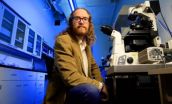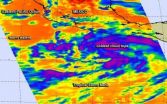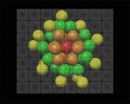(Press-News.org) (Edmonton) Thanks to important discoveries in basic and clinical research and technological advances, the fight against cancer has mobilized into a complex offensive spanning multiple fronts.
Work happening in a University of Alberta chemistry lab could help find new and more selective therapies for cancer. Researchers have developed a compound that targets a specific enzyme overexpressed in certain cancers—and they have tested its activity in cells from brain tumours.
Chemistry professor Christopher Cairo and his team synthesized a first-of-its-kind inhibitor that prevents the activity of an enzyme called neuraminidase. Although flu viruses use enzymes with the same mechanism as part of the process of infection, human cells use their own forms of the enzyme in many biological processes.
Cairo's group collaborated with a group in Milan, Italy, that has shown that neuraminidases are found in excess amounts in glioblastoma cells, a form of brain cancer.
In a new study, a team from the National Cancer Institute tested Cairo's enzyme inhibitor and found that it turned glioblastoma cancer stem cells—found within a tumour and believed to drive cancer growth—into normal cells. The compound also caused the cells to stop growing, suggesting that this mechanism could be important for therapeutics. Results of their efforts were published Aug. 22 in the Nature journal Cell Death & Disease.
Cairo said these findings establish that an inhibitor of this enzyme could work therapeutically and should open the door for future research.
"This is the first proof-of-concept showing a selective neuraminidase inhibitor can have a real effect in human cancer cells," he said. "It isn't a drug yet, but it establishes a new target that we think can be used for creating new, more selective drugs."
Long road from proof of concept to drug
Proving the compound can successfully inhibit the neuraminidase enzyme in cancer cells is just the first step in determining its potential as a therapy.
In its current form, the compound could not be used as a drug, Cairo explained, largely because it wasn't designed to breach the blood-brain barrier making it difficult to reach the target cells. The team in Milan had to use the compound in very high concentrations, he added.
The research advances our understanding of how important carbohydrates are to the function of cells. Although most of us think of glucose (blood sugar) as the only important sugar in biology, there is an entire area of research known as glycobiology that seeks to understand the function of complex carbohydrate structures in cells. Carbohydrate structures cover the surface of cells, and affect how cells interact with each other and with pathogens.
Scientists have known for decades that the carbohydrates found on cancer cells are very different from those on normal cells. For example, many cancers have different amounts of specific residues like sialic acid, or may have different arrangements of the same residues.
"The carbohydrates on the cell surface determine how it interacts with other cells, which makes them important in cancer and other diseases. So, if we can design compounds that change these structures in a defined way, we can affect those interactions," Cairo explained. "Finding new enzyme targets is essential to that process, and our work shows that we can selectively target this neuraminidase enzyme."
Although there has been a lot of work on targeting viral neuraminidase enzymes, Cairo's team has found inhibitors of the human enzymes. "The challenge in human cells is that there are four different isoenzymes. While we might want to target one for its role in cancer, hitting the wrong one could have harmful side-effects," he said.
The U of A team reached out to their colleagues in Milan who were studying the role of a specific neuraminidase isoenzyme in cancer cells isolated from patients. Cairo approached them about testing a compound his team identified last year, which was selective for the same isoenzyme.
"I expected it would do something, but I didn't know it would be that striking. It came out beautifully," Cairo said.
The U of A team is already working on improving the compound, and developing and testing new and existing inhibitors using a panel of in vitro assays they developed.
"We've been working on these enzymes for about five years. Validation of our strategy—design of a selective neuraminidase inhibitor and application in a cell that overexpresses that enzyme—is an achievement for us."
INFORMATION:
The U of A's team was funded by the Alberta Glycomics Centre, the Cancer Research Society and the Natural Sciences and Engineering Research Council.
New enzyme targets for selective cancer therapies
2014-08-22
ELSE PRESS RELEASES FROM THIS DATE:
Women's health and 'Fifty Shades:' Increased risks for young adult readers?
2014-08-22
New Rochelle, NY, August 21, 2014—Popular fiction that normalizes and glamorizes violence against women, such as the blockbuster Fifty Shades series, may be associated with a greater risk of potentially harmful health behaviors and risks. The results of a provocative new study are presented in the article "Fiction or Not? Fifty Shades Is Associated with Health Risks in Adolescent and Young Adult Females," published in Journal of Women's Health, a peer-reviewed publication from Mary Ann Liebert, Inc., publishers. The article is available free on the Journal of Women's Health ...
UH Case Medical Center's Dr. Parikh authors SCAI paper on renal artery stenosis treatment
2014-08-22
CLEVELAND – Renal artery stenting to open blockages in the kidney arteries may benefit patients who have historically been excluded from modern clinical trials, according to new recommendations for renal artery stenosis e-published in Catheterization and Cardiovascular Interventions today by the Society for Cardiovascular Angiography and Interventions (SCAI).
University Hospitals Case Medical Center's Sahil Parikh, MD, Director, Interventional Cardiology Fellowship Program and Professor of Medicine, Case Western Reserve University School of Medicine was the lead author ...
Use a rule of thumb to control how much you drink
2014-08-22
AMES, Iowa – Sticking to a general rule of pouring just a half glass of wine limits the likelihood of overconsumption, even for men with a higher body mass index. That's the finding of a new Iowa State and Cornell University study to be published in a forthcoming issue of the International Journal of Drug Policy.
Laura Smarandescu, lead author and an assistant professor of marketing at Iowa State, says the research team looked at a variety of factors to understand and control over pouring. Researchers found BMI affected how much men poured, but had no influence on women. ...
NASA sees massive Tropical Storm Lowell close enough to trouble Baja California
2014-08-22
Although Tropical Storm Lowell is not over land the storm is large enough to cause strong ocean swells in Baja California. NASA's Terra satellite passed over Lowell and captured an image that shows how it dwarfed Tropical Storm Karina.
The National Hurricane Center noted that swells generated by Lowell will affect the west coast of the Baja California, Mexico, peninsula and portions of the coast of southern California through the weekend of August 23 and 24. These swells are likely to cause life-threatening surf and rip current conditions.
NASA's Terra satellite passed ...
NASA's infrared data shows newborn Tropical Storm Marie came together
2014-08-22
Powerful thunderstorms in newborn Tropical Storm Marie were seen stretching toward the top of the troposphere in infrared imagery from NASA's Aqua satellite.
NASA's Aqua satellite passed over Tropical Storm Marie on Aug. 21 at 20:05 UTC when it was still classified as a low pressure area. The Atmospheric Infrared Sounder or AIRS instrument aboard Aqua read cloud top temperatures in the storm, and showed cloud tops as cold as -63F/-52C around the storm's center and in bands of thunderstorms east and south of the center. AIRS data showed that Marie is located in very warm ...
Women with severe, chronic health issues are screened for breast cancer less often
2014-08-22
TORONTO, Aug. 22, 2014 — Women with severe disabilities and multiple chronic conditions are screened for breast cancer less often than women with no disabilities or no chronic conditions, a new study has found.
They are also screened less often than women with moderate disabilities or women with only one chronic condition, according to Dr. Sara Guilcher, an affiliate scientist with the Li Ka Shing Knowledge Institute of St. Michael's Hospital.
Dr. Guilcher said women with disabilities often have other measures of social vulnerability, such as low income and low education ...
Many patients are discharged without a diagnosis
2014-08-22
Chest pain, breathing difficulties, fainting. Each year approx. 265,000 Danes are acutely admitted to medical departments with symptoms of serious illness. New research from Aarhus University and Aarhus University Hospital now shows that many of them – as many as every fourth patient – are sent home again without receiving a diagnosis of the severe symptoms that led to the acute hospitalisation.
"Naturally, there is no need for a diagnosis if the examinations at the hospital disprove that there is a serious illness. So some patients will always be discharged without a ...
Study shows epigenetic changes in children with Crohn's disease
2014-08-22
August 22, 2014 – A new study finds a wide range of epigenetic changes—alterations in DNA across the genome that may be related to key environmental exposures—in children with Crohn's disease (CD), reports Inflammatory Bowel Diseases, official journal of the Crohn's & Colitis Foundation of America (CCFA). The journal is published by Lippincott Williams & Wilkins, a part of Wolters Kluwer Health.
The study provides "compelling evidence" of alterations of DNA in several regions of the genome in children with CD, according to Professor Jack Satsangi of University of ...
A breakthrough in imaging gold nanoparticles to atomic resolution by electron microscopy
2014-08-22
Nanometre-scale gold particles are intensively investigated for application as catalysts, sensors, drug delivery devices, biological contrast agents and components in photonics and molecular electronics. Gaining knowledge of their atomic-scale structures, fundamental for understanding physical and chemical properties, has been challenging. Now, researchers at Stanford University, USA, have demonstrated that high-resolution electron microscopy can be used to reveal a three-dimensional structure in which all gold atoms are observed. The results are in close agreement with ...
The striatum acts as hub for multisensory integration
2014-08-22
A new study from Karolinska Institutet in Sweden provides insight on how the brain processes external input such as touch, vision or sound from different sources and sides of the body, in order to select and generate adequate movements. The findings, which are presented in the journal Neuron, show that the striatum acts as a sensory 'hub' integrating various types of sensory information, with specialised functional roles for the different neuron types.
"The striatum is the main input structure in the basal ganglia, and is typically associated with motor function", says ...






